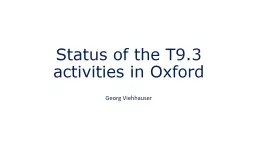

Georg Viehhauser Overview Various activities are going on in parallel Vibration setup Airflow setup FSI Climate chamber Photogrammetry Activities are a on a spectrum of Oxford core activities mostly ATLAS to pure AIDA projects ID: 778160
Download The PPT/PDF document "Status of the T9.3 activities in Oxford" is the property of its rightful owner. Permission is granted to download and print the materials on this web site for personal, non-commercial use only, and to display it on your personal computer provided you do not modify the materials and that you retain all copyright notices contained in the materials. By downloading content from our website, you accept the terms of this agreement.
Slide1
Status of the T9.3 activities in Oxford
Georg Viehhauser
Slide2Overview
Various activities are going on in parallel
Vibration setup
Air-flow setupFSIClimate chamberPhotogrammetryActivities are a on a spectrum of Oxford core activities (mostly ATLAS) to pure AIDA projectsThe first external user (Bristol/PLUME) has visited and we continue studies on their devicesWe take the first external user as a milestone and have written the corresponding milestone report (still needs submitting)We keep learning a lot about the various technologiesAIDA-funded post-doc is now gone (since January) Work is done by me and small effort from Armin Reichold)
2
Slide3Vibration setup I
Frequency scans
Vibration amplitude equalized to 5 m
gSensitivity of accelerometers marginalNew sensor boards with 5× sensitivity being madeLots of things learnedPlayed for some time to find optimum geometry and clampingCan’t operate more than one capacitive sensor on silicon - low frequency (< 5 Hz) noise introducedMode-shape measurement by moving displacement sensor
3
Shaker motor
Accelerometers
Capacitive displacement sensors
PLUME ladder
Slide4Vibration setup II
Three resonance frequencies below 500 Hz identified: 51.5 Hz (Q = 15-16), 170-172 Hz and 407-408 Hz
Mode shapes for first and second mode as expected for
simple fixed-free beam, but third mode not (torsional mode? Non-uniformity along ladder?)Future studies: Can we identify torsional modes? (problem: finite size of capacitive sensor vs width of ladder)Response to broad-band excitation4
Note sensitivity
of ~10 nm
Slide5Air flow setup
This has been the task of the AIDA-funded post-doc
He never completed this setup
I am now trying to make his designs work – takes time (also, we do not have expertise on air flow systems)We have air-flow (no cooling)Without device under test: 6 m/sBut dropped by factor 10 when we installed PLUME ladderOptimized air flow: now 3 m/s with ladder in place (although flow at device is probably higher due to restriction of channel)Displacement measurements:Abandoned plan to use capacitive sensors (for now): worry that they affect airflow
Tried FSI system: could not get reflection from Silicon (transparent in IR) – will mount small mirror
For now: use reflected laser sensor: Sensitivity is not great and there are still some noise issues
Work ongoing
5
Air flow
Plume ladder in
test channel
Plume ladder in
test
channel (end)
Slide6Frequency Scanning Interferometry
I
nterferometric
distance measurement techniqueAllows for absolute distance measurements with an accuracy of 5×10-7 m Measures distance from collimator to reflective surface (mirror, retroreflector etc.)Originally developed in Oxford for ATLAS ID alignmentNow commercializedProcured on STFC funds a
system
with currently four
lines-of-sight
can easily be upgraded to more
channelsLaser light in the infrared (1550 nm)Can measure distances up to 20 m
We have tested the system on practice setups, but not yet used for real measurementsThis will change soon:
Plan to use it on PLUME ladders (with mirror)To be used on CTE measurements of CF pieces for ATLAS
6
Collimator
Slide7Other activities - photogrammetry
Preparation for ATLAS barrel strip construction (but could be made available to other users)
Survey of large CF cylinders using photogrammetry
Developing software to track variations and methods to cross-calibrate with other survey techniques7
×10 ring deformations from ideal cylinder
Slide8Future plans
Continue work on PLUME ladders
In particular airflow
Collaborate with other usersOriginal plan was to work with ValenciaThis communication was through the AIDA-funded postdoc and has dried upWould like to start this again and hope that there is still interestFurther improvements:Vibration setup: improve accelerometersAir flow setup: include coolingFurther improvements on infrastructure and sensor systems Reviewers have suggested collaboration between T9.2 and T9.3Need to identify relevant questions and corresponding measurementsDeformations under pressure and/or temperature variations? Coolant
flow?
What are the thermal conditions (heat sources and environment)?
To make this useful we need a careful definition of the test and best a realistic use case
We do have a CO
2 blow-off system at Oxford, other opportunities need to be explored… 8